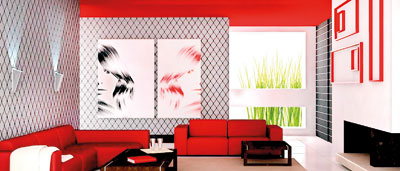Your home is more than just the building
View(s):Architect cum interior decorator Chami Waduge helps you visualise your dream home
“I’ve been a professional architect for the past ten years,” says architect and interior designer, Chami Waduge. A product of Visakha Vidyalaya, she did her higher studies including her postgraduate studies in the United Kingdom where she is now a practising chartered architect. Back home in Sri Lanka Chami is known as an interior designer.
“I have my own firm both in Sri Lanka and the UK. I visit Sri Lanka every year and since our country is going through a developing stage now, I think it’s the best time for us to pay attention to even the small detalis, starting from our homes,” she says.

Chami: Importa-nce of space and colour
“I want to teach people how to decorate their homes by themselves according to their own preferences at a lower cost. Your house reflects who you are. It could reflect your style, profession and even your personality. Let your house speak for you. Add value to your house,” she says. Pointing out that in Sri Lanka people pay more attention to building the house, finding the best architect, she added, “But it’s not just building, even the interior decor is important. Buying the most expensive furniture and filling your house with them doesn’t increase the value of your house.”
Chami’s advice is practical. “First you need a plan. You should decide what kind of image you need and work out your budget. You have to choose the right colour for your house. It has to match your surroundings as well as the layout of your house. For example colours like oranges and reds should not be mixed with colours like blues and greens simply because they belong to separate colour families,” she says.
She recommends using plants as they not only suit our conditions but also add natural beauty and help curb dust, a common problem for most home makers. “Though we Sri Lankans like wooden furniture, we have to make sure it matches other arrangements in our house. We should use wooden furniture only if we have a wooden floor or ceiling or near a wooden staircase. Even then the colour has to match.
If your walls are white, darker wood would look better but if your walls are, for example orange, refrain from going for darker wood shades. A smaller space, especially like apartments can be made to look bigger and more spacious with the correct use of colour, furniture and other accessories,” she says.
For more see Chami’s website: www.chamindesign.com
 |
 |
Chami’s top ten tips for colour
1. People worry about losing the flow in a house if they use different colours, but if you use colours with the same tonal weight, you still create a flow. For instance, Sudbrook Yellow and Bookroom Red are from two different colour families but as they have the same tonal value you can go seamlessly from one room to the other.
2. If you’re wary of colour, put it somewhere you don’t have to look at it all the time, like your guest bedroom. There are many ways to add an accent of colour to get yourself used to it: the insides of bookcases, the inside back of a kitchen dresser, a little piece of furniture.
3. I love to paint the spindles of a staircase a darker colour, so they create a dark core up the centre of the house, which makes everything else seem much lighter. In the same way, paint the kitchen island darker so everything else feels lighter, and the space feels grounded. If you don’t have an island, paint the legs of the table a darker shade.
4. If you’re using a strong design of wallpaper, you don’t want a little white line of skirting running along the bottom, so use a paint for the skirting that is either the colour of the wallpaper pattern, or the colour of the background.
5. The way to widen a long, thin room or a corridor is to paint the skirtings dark, and because the darkness is at the bottom, the lighter area above opens up the room. Dark below a dado rail, and lighter above, works even better.
6. Picture rails and dado rails are functional, but we’ve made them into these decorative objects, picking them out. I think it looks hideous to see a bit of wall, then coloured rail, then a bit more wall, a bit more coloured rail. I prefer to paint straight over them.
7. The darker the room, the stronger the colour I put on it; the lighter the room, the lighter the colour I use, to work with the light. Lighter, brighter whites work better in strong sunlight; traditional whites look drab.
8. Don’t sample a colour by painting it on the wall: paint it on two pieces of card and put them in different parts of the room and look at them day and night to see how the colour works. You need two pieces to compare. If you’re choosing wall and woodwork colour, paint the samples proportionately, and it will give you much more of a sense of how they will work together.
9. If you’re painting your front door, paint both door and frame, rather than have a little door in the middle, which makes it look insignificant.
10. The most important point about choosing exterior paintwork is to consider what your neighbours have. You can try and be clever and think, “Oh, I’ll have off-white”, but if your neighbour has bright white, your house will end up looking a bit grubby.
Follow @timesonlinelk
comments powered by Disqus



















